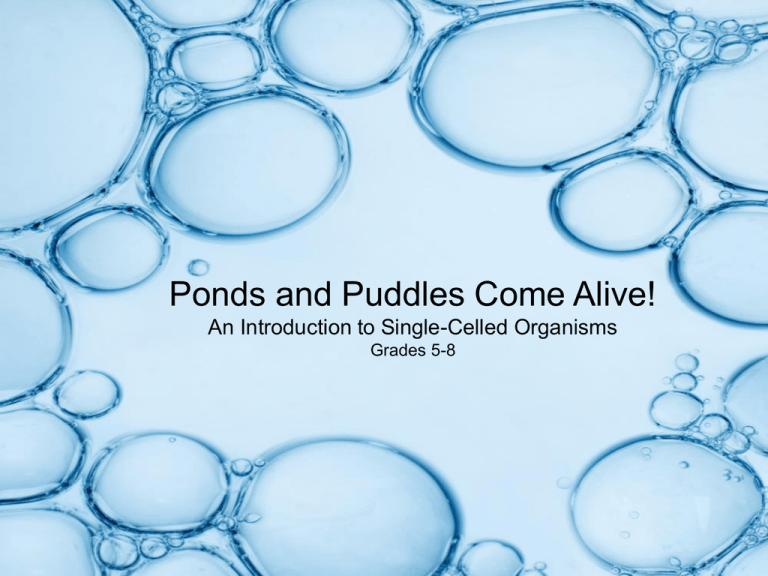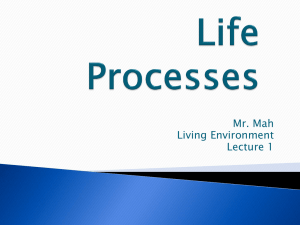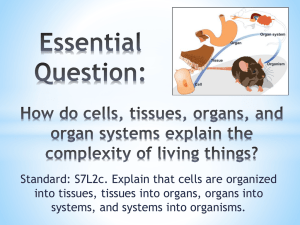
Ponds and Puddles Come Alive!
An Introduction to Single-Celled Organisms
Grades 5-8
Common Core State Standard: Reading Standards for Information Text - Integration of
Knowledge and Ideas 7: Integrate Information presented in different media or formats
(e.g. visually, quantitatively) as well as in words to develop a coherent understanding of
a topic or issue.
Students will conduct physical and virtual experiments to investigate and
identify the characteristics of single-celled organisms and differentiate
between organisms produced by single parents or pairs.
Copyright 2011 New Dimension Media
Teacher Tips
Standards Alignment Information
The study of microscopic single-celled organisms is an essential component of an
education in the biological sciences. Students learn the characteristics of singlecelled organisms in order to make the learning leap to more sophisticated multicellular organisms or complex biological systems (cardiovascular, digestive, etc.).
Individual state standards reflect that mastery of single-celled biology is generally
reviewed as a prerequisite for advanced biological study, and the concepts required
for such mastery are apparent in the Common Core State Standards as well.
Select Inquiry Route
This lesson offers an excellent opportunity for educators to utilize experimental
learning in the classrooms. If microscopes are available, students can explore the
exotic world of microscopic single-celled organisms by examining droplets of pond
water, for example. Don’t worry if there isn’t a pond handy, as you can just leave
some vegetable matter in an open vessel of water for two to three days instead.
Students might draw the creatures they discover under the microscope and describe
their characteristics (shape, color, movement, function, etc.) to their classmates as
brief presentations. Whatever route of inquiry the teacher selects, an amazing
opportunity exists to demonstrate to students the omnipresence of life all around.
Copyright 2011 New Dimension Media
Enduring Understandings
• Single-celled organisms have specialized structures.
• The structures in single-celled organisms serve specific purposes.
• Single-celled organisms are the building blocks of more complicated organisms and
systems.
Essential Questions
• What component make up a single-celled organism?
• What function does each component perform?
• How are single-celled organisms related to more complex forms of life?
Copyright 2011 New Dimension Media
Lesson Objectives and Project-Based Learning
Lesson Objectives
• Students will identify the structures in single-celled organisms.
• Students will explain the function of each structure in a single-celled organism.
• Students will illustrate how single-celled organisms are related to more complex
forms of life.
Project-Based Learning
Students will view microscopic organisms in the classroom using microscopes or a
virtual equivalent and log their observations. They will identify the components of
single-celled organisms (nuclei, cilia, etc.) and their function. Students will evaluate
their progress with a drag-and-drop matching assessment.
Project 1: Students will create their own visual representations of single-celled
organisms using hand-drawn illustrations, photo collage or computer art
programs (MS Paint, etc.). Representations must identify components
and label their functions.
Project 2: Students will create a complex organism by combining their
representations.
Copyright 2011 New Dimension Media
Teacher Tips:
Let’s get kids excited about the exotic world of microorganisms they have been unknowingly
swimming with for their entire lives. If microscopes are available, students can use local water
samples or samples cultivated in the classroom. Alternatively, students can use the video
resources available on the following slide. Either way, encourage students to log their
observations of the microscopic world in their journals.
As students look through the microscopes or watch the videos, encourage them to guess
what the functions the different components of the organism serve. Prompt them with
questions like: how do you think they move? Or, where do you think digestion happens?
Copyright 2011 New Dimension Media
Video Resources: Paramecium
Click on the titles below to launch videos of paramecium!
Paramecium: An Introduction to Single-Cell Biology!
Paramecium Under The Microscope!
Copyright 2011 New Dimension Media
Draw what you see in the microscope.
Assessment criteria:
1.
Detail - when you look through a microscope,
you are looking at something magnified and, as a
result, you will be able to see tiny details. Great
scientific drawings are detailed.
2.
Write a description that a scientist would add.
This goes beyond labels and is actual text that is
focused on the details you drew and your
knowledge around what you see.
3.
Don’t limit yourself to what you already know.
Use your research and inquiry skills to find out all
you can about what you see and drew.
4.
Write like a scientist. This evokes a writing style
that is straightforward, descriptive and factual.
5.
Use textual features to emphasize important
information in your written description. Textual
features include bolding, italics, highlighting, etc.
Copyright 2011 New Dimension Media
Draw what you see in the microscope.
Name:
Write your description here:
Copyright 2011 New Dimension Media
Draw what you see in the microscope.
Name:
Write your description here:
Feedback - 6 points possible
Feedback - 4 points possible
___ Description was accurate.
___ Drawing was neatly constructed.
___ Details were shown using line and
shape.
___ All components were identified.
___ Drawing was verified by peer
(checked against actual sample).
___ Description was detailed.
___ Textual features emphasized key
information.
___ Organism was identified.
___ When written description is
seperated from drawing, it can
be easily matched up correctly.
Copyright 2011 New Dimension Media
Identifying the components of the paramecium
Drag the labels to the correct part of the diagram.
Micronucleus
Contracile vacuole
Trichocysts
Macronucleus
Gullet
Food vacuoles
Anal pore
Cilia
Lysosomes
Oral groove
Copyright 2011 New Dimension Media
Identifying the components of the paramecium
Drag the labels to the correct part of the diagram.
Copyright 2011 New Dimension Media
Virtual Lab Resources
On the
Move
Copyright 2011 New Dimension Media
Teacher Tips
In this project, students will be expected to create a
representation of a single-celled organism, either a
paramecium or another creature they have discovered
through their microscope or the virtual lab videos.
Encourage students to go beyond simply reiterating the
basic labels and descriptions they have learned earlier in
this lesson. It is essential that there is a creative and
constructive element to the project, so for this lesson
component students are restricted from using images
they find on the Internet.
Copyright 2011 New Dimension Media
Project: Create an Organism
Students, this is your chance to take
everything you have learned and use it
creatively! Create your own single-celled
organism
Steps to Success
1.
2.
3.
Determine which organism you are
going to create. Are you creating an
amoeba, euglena or paramecium?
Use what you already know. Label
the organims’s components and
describe their functions. Use your
own words for the descriptions.
Create your own organism using
hand-drawn illustrations, photo
collages or original computer artwork.
Create something of your own! Do no
print a photo or picture off the
computer if it is not something you
did not make yourself.
Copyright 2011 New Dimension Media
Teacher Tips:
One of the objectives of this lesson is to illustrate how singlecelled organisms are related to more complex forms of life.
Here’s a little scientific background to point you in the right
direction:
The task is to manipulate the creations of your students, or the
students themselves, into shapes that mimic more complex
organisms or systems.
The students, or their creations, cannot be surrounded by other
students or creations, unless the group re-forms to develop a
complex solution to the problem. Think about how you will identify
ineffective shapes and encourage students to regroup into complex
forms.
Copyright 2011 New Dimension Media
Teacher Tips Continued:
Below are suggestions for how you can identify ineffective shapes
and encourage students to regroup into complex forms.
Copyright 2011 New Dimension Media
Project: Single-Celled to Complex Organisms
Students, those single-celled organisms you created were great! Now, our next
challenge is to figure out how single celled organisms develop into more
complex organisms like jellyfish or chipmunks or anything else.
Here’s what we’ll do:
The first student will stand up. That student, or
their organism representation, is the first singlecelled organism. The next student, or their
organism representation, must arrange with the
first student to create a two-celled organism. The
next student will arrange with the previous two to
create a three-celled organism, and so on, until
either all students are part of the complex
organism or the organism fails to develop
complexity and fails. Your teacher will steer you in
the right direction if your class organism starts to
develop unsuccessfully.
Check out these additional resources for learning more about single
celled and complex organisms!
Copyright 2011 New Dimension Media
Synthesizing what you have learned:
Compare and contrast the structure and function of single-celled and multi-celled
organisms. Use a diagram to help you “show or visualize” the similarities and
differences between single-celled and multi-celled organisms.
Copyright 2011 New Dimension Media
Teacher Notes About Copyright
Throughout this lesson you might have noticed the 2011 Copyright New Dimension Media tag. The meaning of this tag
is important for you to understand in terms of your use in upholding copyright law.
1.
You cannot distribute this lesson plan beyond your school boundaries.
2.
Film producers receive royalties on their work and distributing these lessons outside of this agreement means they will
not receive remuneration for their work.
3.
If you enjoy high-quality media content, then you will want film producers to keep producing. This will only happen if
they receive the royalties they have agreed to in their contract which, in turn, allows educational companies like us to
extend high-quality media content to our customers
4.
Copyright law also covers the images in this lesson. These cannot be re-purposed and distributed outside of this
lesson. Doing so does break copyright law.
5.
We are required to say this in legal terms so our legal disclaimer is below:
License to Use Lesson Plan and Content: NDM hereby grants to the Approved Teacher a non-exclusive, non-transferable license to display and use the content,
images and methods included in this Lesson Plan. The license also applies to other Teachers in the Approved Teacher school District only. This Lesson Plan cannot
be distributed or sold outside the Approved Teacher District.
Restrictions on Use: Teachers shall not make or distribute unauthorized copies of the content, images or methods included in this Lesson Plan. Unauthorized use
or distribution of content at unlicensed sites is a violation of intellectual property rights and subject to additional fees and charges.
Trademarks and Copyrights: New Dimension Media, CCC! (Core Curriculum Content!) and other trademarks contained in the content and Lesson Plan are the
trademarks of NDM. Third party trademarks, trade names, product names, logos, images, copyrights or other proprietary notices, legends, symbols or labels in the
content and Lesson Plan are the property of their owners. The license to use this Lesson Plan does not authorize Teachers or students to use the names,
trademarks or copyrights of NDM or its licensors or third parties except as set forth herein.
Copyright 2011 New Dimension Media
We hope you enjoy using this lesson with your students. If you have an idea
or suggestion on how we may improve this lesson, we would love to hear
from you!
Please use the Contact Us page of the Connection site to provide us with
your valuable feedback. When commenting on this lesson, please refer to the
title of the lesson in your comment.
You will hear back from us and maybe even see your suggestions
incorporated in a new version of this lesson plan!
Don't forget to also follow us daily on Facebook and Twitter for more great
instructional ideas.
We hope you come back again for more great interactive lesson plans made
especially for you and your students. Have fun boosting student achievement
at your school!
Sincerely,
The New Dimension MediaInstructional Design Team
Copyright 2011 New Dimension Media









